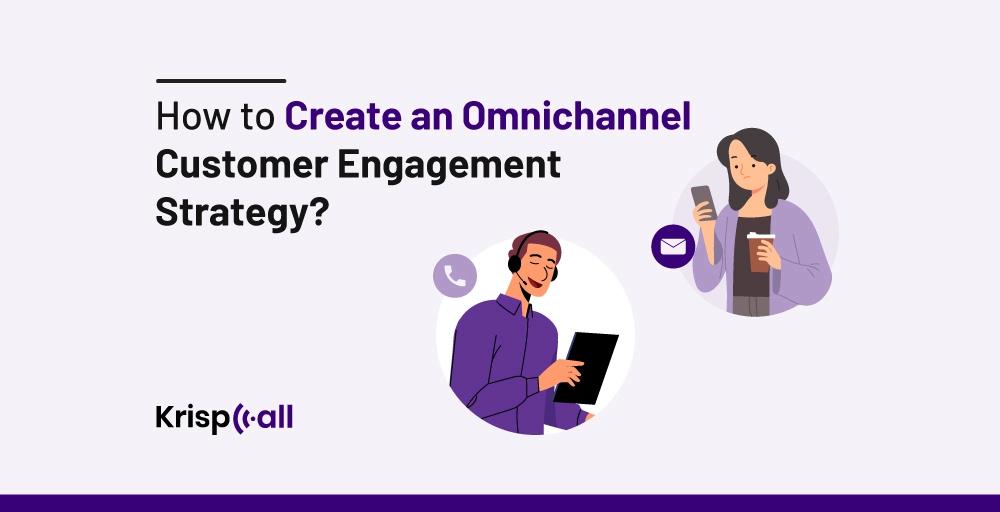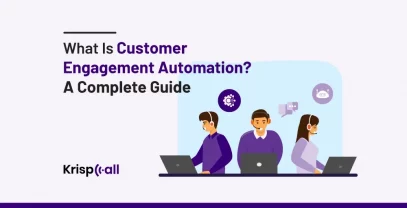The way people shop has changed a lot thanks to digital technology, such as the Internet, social media, and email. Today, shoppers can choose from many options, such as websites, mobile apps, and more.
Businesses cannot rely solely on good customer service to keep people happy. They must consistently engage customers through various methods.
So, what should a company do if their messaging isn’t reaching the desired audience? The answer is to develop an omnichannel customer engagement strategy.
This article will teach you about omnichannel customer engagement, its importance, advantages, and components, and how to create one.
🔑 KEY HIGHLIGHTS
- Omnichannel customer engagement combines all marketing methods to provide a personalized experience for customers across all touchpoints (website, store, phone, etc.).
- Customer engagement strategy helps you learn about customer behavior and personalize interactions for better engagement and sales.
- Components of customer engagement include consistent engagement across channels, combining human and AI interaction, and personalized messaging.
- The customer engagement strategy provides a complete customer view, creates full customer profiles, allows grouping based on similarities, and keeps customers happy.
- Customer engagement challenges include creating a consistent user experience everywhere, integrating all customer information, and personalizing each experience.
What is Omnichannel Customer Engagement?

Omnichannel customer engagement is a strategy that combines all essential marketing methods to provide a personalized experience for customers no matter how they choose to contact the company.
This could be online, in a store, or on their phone. Keeping the engagement consistent across channels boosts satisfaction and loyalty since it gives customers a smooth experience through every option.
Omnichannel Customer Engagement Examples
Many big companies worldwide have successfully integrated all their methods of contact to provide excellent customer service across devices and places. This allows them to offer a smooth experience and consistently unlock new possibilities.
Some top examples of omnichannel customer engagement are:
- Nike
Nike is a good example of a brand that smoothly connects stores, websites, and mobile apps. Its app immediately makes customers important, discovering what they like during signup.
Then, it easily links them to other Nike apps, such as fitness and training apps. The app also coordinates with physical stores. Customers can reserve items for store pickup or get suggestions based on past buying and interests. This access to data and consistent experience increases online and repeat sales.
- Starbucks
Starbucks does very well combining their app, in-store orders, and rewards program. The app lets people prepare drinks for quick pickup at Starbucks nearby.
The app also offers personalized suggestions, tracks points earned, and lets people reload their gift cards. Starbucks smoothly links digital channels to what happens at physical stores, allowing people to interact with the company in their own way, making the experience worthwhile.
Why is an Omnichannel Customer Engagement Strategy important?
In today’s world, people can easily switch to a new brand with one click. So, connecting personally with customers is extremely important. You need to interact with and build individual relationships with each person genuinely.
Omnichannel Customer Engagement is essential because it gives you valuable insights that fuel campaigns customized for individuals. The more engaged your customers are, the better your combined approach will work.
Components of Omnichannel Engagement Strategy
These are the critical components of an Omnichannel Engagement Strategy:
- Consistent engagement across channels: Customers often start interacting with a brand in one place and then continue in another channel. Maintaining consistency in the customer experience is vital, no matter their contact method.
- Valuable customer communities: Online communities are great customer engagement platforms since they allow people to communicate comfortably, ask questions, find answers, share experiences, suggest ideas, and give feedback about features.
- Coordinating humans and AI: Making the most of resources and the customer experience involves understanding humans and AI have different but complementary skills. Working together with AI harmoniously achieves the best results.
- Giving importance to feedback: Listening to what customers say about a brand is key to grasping their perspective and satisfaction, recognizing wants and goals, and considering suggestions to improve products and services.
- Personalized Tailoring: An analytics-focused approach is necessary to analyze data to personalize engagement effectively. Gathering info, combining it with customer profiles, defining targeted contact paths by channel, and measuring outcomes from customized efforts enables engagement that is suited for each individual.
What are the Advantages of Omnichannel Customer Engagement?
It’s necessary for businesses to provide reasons for customers to keep coming back. An omnichannel engagement system can offer several advantages, such as:
1. Putting All Customer Info Together
People expect more from brands now than before. Companies have to work hard to keep up with what customers want. Ultimately, customers want their needs met right away.
An omnichannel customer engagement strategy does exactly that. It brings all a customer’s details into one organized place, and brands can craft experiences tailored just for each person.
2. Putting Together Complete Customer Profiles
Information about people and why they act in specific ways is important for understanding how to interact with customers. Omnichannel customer engagement lets companies know more about what people like and don’t like. This helps companies make smart choices and provide the best experiences.
The omnichannel routing channel combines all the times and places someone comes into contact with the brand into one profile just for them. They also have clues and predictions about how clients act so marketers can make better decisions on an individual basis.
3. Grouping Customers Based on Similarities
New technologies like AI have helped improve how brands interact with people. AI tools look at everything customers do and learn from their behavior over time.
Businesses can then group people based on what they like, who they are, and when they may stop doing business, take a break, or make a buy. The omnichannel platform shows which groups, ways of interacting, or strategies companies should focus on or change.
4. Keeping Customers Happy and Coming Back
When companies communicate with them in many different ways, customers feel thought of and supported. Engaging back and forth actively builds a connection, which makes customers loyal.
The omnichannel system helps businesses use programs and solutions to recognize better who may stop shopping soon and keep them hooked for longer. Consistency across channels helps increase customer retention and loyalty over time.
What are the Challenges of building an Omnichannel Customer Engagement Strategy?
Providing customers with a consistent, personalized omnichannel experience is important to minimize the number of times they stop doing business with a company.
But, when creating an engagement strategy, organizations commonly encounter some challenges with omnichannel marketing, such as:
I. Making User Experience the Same Everywhere
It’s not good enough for a customer to only have a great time on one part of the business, like the website. The experience must feel the same no matter where they interact with the brand.
For example, if someone really likes using the company’s website, they’ll want the store, social media, and cell phone app to provide just as excellent service. However, many companies struggle to make everything uniform for users wherever they go.
II. Bringing Together All Customer Information
When you combine different ways customers interact, like websites and stores, into one place, you gather all the information about them from those places. Usually, the data formats from each channel are not the same, making it hard to put them together well.
Figuring out how to organize the data so it connects smoothly is challenging when planning to interact with customers across channels.
III. Keeping it Interactive
One of the hardest things for websites is how to keep interacting with visitors after they stop browsing. How can you stay in touch with them on Facebook or elsewhere?
It is challenging to devise creative solutions to identify shoppers and successfully continue conversations with them across the different ways they spend time with your brand.
IV. Making Each Experience Unique
It’s important to tailor each customer’s experience just for them to keep people interested and involved. But figuring out ways to customize everything while protecting private information and securing data isn’t easy.
Companies need to follow privacy laws in the countries where customers live and keep information safe from being stolen or used wrongly. With all those challenges, it’s hard to add that personal touch.
Still, personalization is essential because it makes people want to interact more and stick with businesses, which helps companies stay competitive against others in the same field.
How to Create an Omnichannel Customer Engagement Strategy?
Today, customers expect companies to know them and tailor interactions based on the individual. Here is how you can create an omnichannel customer engagement strategy:
1. Find Out Where Customers Go
The best thing is to look again at the types of people who buy from you and see where they go to interact with your company.
Figuring this out helps you know which methods of connecting, like websites or ads, make the most sense for your combined interaction approach. Paying attention to what platforms the people you sell actually use saves money by avoiding places they don’t hang out.
2. Map Out What Customers Do
Once you know which places customers hang out, the next step is to map their whole experience moving between different spots. Mapping the entire customer journey helps ensure everything flows smoothly and there are no gaps in communication across different parts of the business.
As you map everything out, think about a few things. 👉 How does each method of connecting, like social media, work on its own? How does one channel lead people to the next? How does each part of connecting eventually get people to buy something?
3. Make Content Fit Each Connection Spot
Connecting across different platforms isn’t about sending the exact same thing everywhere. Each channel works best with certain types of information. For example, pictures do well on Instagram and Facebook, videos are suitable for YouTube, short messages fit Twitter well, and lengthy written updates are better in emails.
Even so, everything you share should work in a coordinated way to meet your business targets. Don’t repeat everything exactly—tailor the form and style to suit customers’ needs. Understanding what kind of material each channel’s audience responds to best helps grab attention and keep engagement high in all the right spots.
4. Give Customers Cross-Channel Assistance
Because people connect with companies in many different ways, offering assistance on every channel is really important. Customer assistance builds trust that a brand cares about them and is reliable. This makes people want to stick around.
So make sure your support team can handle whatever questions come in wherever customers reach out, whether online, over the phone, or through social media and apps. Having help available across all channels keeps things simple and convenient.
5. Pay Attention to Your Marketing Set-Up
To connect with people smoothly across different methods, your marketing tools need to support the work. An organized system helps you follow goals, monitor information, and study what works.
The omnichannel customer platform combines details on items, client profiles, contacts between brands and people, and what sells. Having all the essential stuff joined in one place helps maximize opportunities everywhere you communicate and has the flexibility to keep growing as the brand expands.
Best Practices to Adopt Omnichannel Customer Engagement Strategies
For the best results, keep these in mind while creating an omnichannel customer engagement strategy:
Keep Customers as Your Top Priority
Build your combined marketing approach around the customer. Find out where they like connecting most and concentrate on improving those methods. Study who buys from you so you know how to shape contacts and what they see.
Make interactions and responses specific to each customer. Provide material personalized for their interests. Tailor what you share to fit people’s wants and needs.
Keep Your Brand Image Consistent
Have you noticed how a little symbol instantly makes you think of a famous shoe company? Or how just hearing “I’m lovin’ it” reminds you of a popular fast food place? That’s the effect of strong branding and messaging done right.
It’s important that your company portrays the same look, feel, and ideas no matter where people interact with it. Customers should immediately recognize your brand across different methods, such as websites, apps, and ads.
Connect Channels for Best Results
Track how and when people move between channels so you understand full journeys. Then, link things together ideally so interactions flow continuously. Use technology that instantly shares details about a customer on any channel.
This gives you one complete picture regardless of where contact happens. Identify common paths and places where switches occur. Streamline the hand-offs to remove bumps. Customers should perceive brands as united across devices and places rather than separate experiences.
Prepare Workers Through Learning
Give your team the ability and resources to provide amazing experiences across all contact methods. Ensure everyone gets full instruction on understanding customers, speaking smoothly, and how each platform works uniquely.
Enable staff to make choices and solve problems quickly. Correctly training staff gives them the confidence to represent the brand well. Helping staff grow skills gives them ownership to please people independently.
Provide a Smooth Experience on All Devices
With 85% of people wanting mobile options that match using a computer, focusing on phones and tablets is really important now. Make sure your website adjusts well to fit smaller screens.
Customers want things to work and feel the same whether they’re on a phone, tablet, or PC. Check that images, text, and navigation all appear cleanly resized. Links and buttons also need appropriate sizing if you want customers to click on them.
Conclusion
Developing a good omnichannel customer engagement strategy can pay off for your marketing team. It can be challenging to guarantee that the customer experience remains uniform and accommodates customers’ wants across many avenues.
However, having the right omnichannel tools can help you solve these issues and achieve great outcomes for your business. When customers can get what they need regardless of whether they use your company’s website, app, social media, etc., it leads to happier repeat customers.
An omnichannel approach requires work, but successfully implementing it with the proper technology makes customers pleased with their brand interactions in a unified way.





